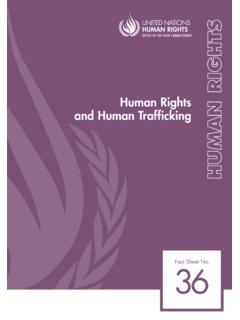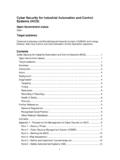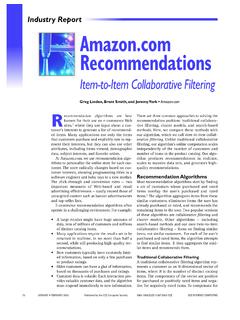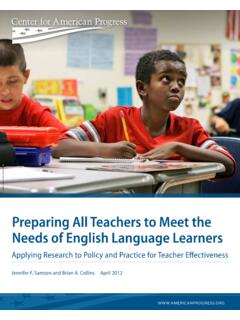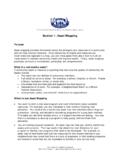Transcription of The Economics of Fair Trade - Harvard University
1 Journal of Economic Perspectives Volume 28, Number 3 Summer 2014 Pages 217 236 fair Trade is a labeling initiative aimed at improving the lives of the poor in developing countries by offering better terms to producers and helping them to organize. Although fair Trade certified products still comprise a small share of the market for example, fair Trade certified coffee exports were percent of global coffee exports in 2009 growth has been very rapid over the past fair Trade coffee sales have increased from 12,000 tonnes in 2000 ( fairtrade International, 2012b, p. 24) to 123,200 tonnes in 2011 ( fairtrade International, 2012a, p.)
2 41).Whether fair Trade can achieve its intended goals has been hotly debated in academic and policy circles. In particular, debates have been waged about whether fair Trade makes economic sense and is sustainable in the long run. Develop-ment economist Paul Collier (2007, p. 163), in his book The Bottom Billion, writes: They [ fair Trade certified farmers] get charity as long as they stay producing the crops that have locked them into poverty. The Economist (2006) writes: perhaps the most cogent objection to fairtrade is that it is an inefficient way to get money to poor producers. Those on the other side of the debate argue that fair Trade benefits farmers by providing higher incomes and greater economic stability.
3 For example, Laura Raynolds (2009, p. 1083) writes that fair Trade offers farmers 1 The statistic is for coffee sold as fairtrade by fair Trade International. Statistics on fairtrade exports are from fair Trade International, and those on total exports are from International Coffee Economics of fair Trade Raluca Dragusanu is a PhD candidate in Business Economics , Harvard University , Cambridge, Massachusetts. Daniele Giovannucci is the cofounder and President of the Committee on Sustainability Assessment (COSA). Nathan Nunn is Professor of Economics , Harvard University , Cambridge, Massachusetts. The authors email addresses are Raluca and doi= Dragusanu, Daniele Giovannucci, and Nathan Nunn218 Journal of Economic Perspectivesand agricultural workers in the global South better prices, stable market links and resources for social and environmental projects and that it provides consumers with product options that uphold high social and environmental standards.
4 The emergence of modern fair Trade labels can be traced back to 1988, when a faith-based nongovernment organization from the Netherlands began an initiative that aimed to ensure that growers of crops in low-income countries were provided sufficient wages. The organization created a fair Trade label for their products. It was called Max Havelaar, after a fictional Dutch character who opposed the exploi-tation of coffee pickers in Dutch colonies. Over the next few years, the concept was replicated in other countries across Europe and North America, with a number of organizations emerging, such as TransFair and Global Exchange. In 1997, the various national labeling initiatives formed an umbrella association called fairtrade International.
5 A common fair Trade Certification mark was launched in 2002 and there are several fair Trade bodies operating 2012, fairtrade International s largest adherent, Transfair USA, split from the organization to launch a parallel label, fair Trade USA. One of the primary reasons for the division was the difference in beliefs about whether the fair Trade label should only be available to small-scale producers. While fairtrade International believes that certification should generally be restricted to small producers, fair Trade USA feels that that large producers and plantations should also be certified. fairtrade , the one-word form, is used by fairtrade International for their certi-fication mark and for references to their specific market.
6 We use fair Trade to refer to the general initiative and movement without reference to a particular Trade attempts to achieve several goals; the primary and best-known is to provide prices that deliver a basic livelihood for producers. In addition, fair Trade has a number of other goals, including longer-term buyer seller relationships that facilitate greater access to financing for producers; improved working conditions; the creation and/or maintenance of effective producer or worker organizations; and the use of environmentally friendly production processes. A third-party certi-fication process regularly checks that producers and suppliers adhere to a set of requirements whose purpose is to achieve these objectives.
7 The fair Trade label that is displayed on certified products is a signal to consumers that the product was produced and traded in accordance with these is one of the many voluntary sustainability standards that have emerged. These standards share some common overlapping goals but each has its own focus and priorities. In addition to fair Trade , other certification standards include Organic, Rainforest Alliance, and UTZ Certified, and there are similarly prominent labels for different products such as those of the Forest Stewardship Council, Marine Stewardship Council, Roundtable on Sustainable Palm Oil, and Global For information on Organic, see the website of the International Federation of Organic Agricultural Movements at For information on UTZ Certified, see.
8 Org. For Rainforest Alliance, see For Forest Stewardship Council, see For Marine Stewardship Council, see For Global , see Also see the summary in Raynolds, Murray, and Heller (2007) and Potts et al. (2014).Raluca Dragusanu, Daniele Giovannucci, and Nathan Nunn 219 The aim of this article is to provide a critical overview of the economic theory behind fair Trade , describing the potential benefits and potential pitfalls. We also provide an assessment of the empirical evidence of the impacts of fair Trade to date. Because coffee is the largest single product in the fair Trade market (see Table 1), our discussion here focuses on the specifics of this industry, although we will also point out some important differences with other commodities as they Mechanisms of fair Trade StandardsThe stated goal of fair Trade is to improve the living conditions of farmers and workers in developing countries.
9 The specific mechanisms for achieving this goal are a combination of guidelines for price negotiation and requirements for certifi-cation, which we summarize ) Price floor. The central characteristic of fair Trade is the minimum price for which a fair Trade certified product can be sold to a fair Trade buyer, which is intended to cover the average costs of sustainable production and meet a broadly determined living wage in the sector (originally set in accordance with the data of the International Coffee Organization). A fair Trade buyer agrees to pay certified producers at least the minimum price when the world price is below this price. In all situations, producers and traders remain free to negotiate higher prices on the basis of quality and other attributes.
10 By providing a guaranteed minimum price for products sold as fair Trade , the price floor is intended to reduce the risk faced by growers. As we discuss in more detail below, there is no guarantee that all coffee that meets the certification requirements and is eligible to be sold as fair Trade is indeed sold as such. Just producing and certifying a product does not guarantee that a buyer will purchase it as fair Trade and provide the associ-ated benefits and price. The relationship between the guaranteed minimum price Ta b l e 1 Number of fairtrade Producers and Workers by ProductProductNumber of producers and workersCoffee580,200Te a258,100 Cocoa141,800 Seed cotton66,500 Flowers and plants37,500 Cane sugar37,200 Bananas20,300 Fresh fruit18,700 Nuts14,300 Note: Data are from Monitoring the Scope and Benefits of fairtrade (2012), fourth edition, fairtrade Journal of Economic Perspectivesand the market price between 1989 and 2014 is shown in Figure 1.










